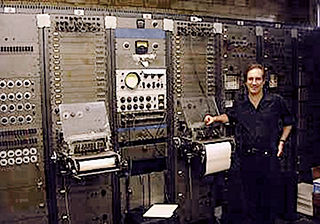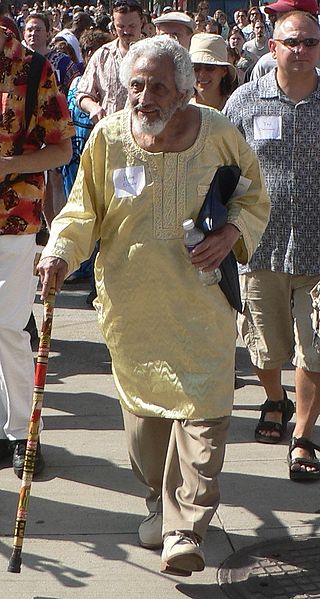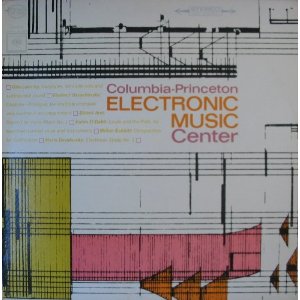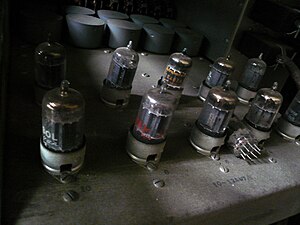Electronic music is a genre of music that employs electronic musical instruments, digital instruments, or circuitry-based music technology in its creation. It includes both music made using electronic and electromechanical means. Pure electronic instruments depended entirely on circuitry-based sound generation, for instance using devices such as an electronic oscillator, theremin, or synthesizer. Electromechanical instruments can have mechanical parts such as strings, hammers, and electric elements including magnetic pickups, power amplifiers and loudspeakers. Such electromechanical devices include the telharmonium, Hammond organ, electric piano and the electric guitar.

An electronic musical instrument or electrophone is a musical instrument that produces sound using electronic circuitry. Such an instrument sounds by outputting an electrical, electronic or digital audio signal that ultimately is plugged into a power amplifier which drives a loudspeaker, creating the sound heard by the performer and listener.

Milton Byron Babbitt was an American composer, music theorist, mathematician, and teacher. He was a Pulitzer Prize and MacArthur Fellowship recipient, recognized for his serial and electronic music.

Miya Masaoka is an American composer, musician, and sound artist active in the field of contemporary classical music and experimental music. Her work encompasses contemporary classical composition, improvisation, electroacoustic music, inter-disciplinary sound art, sound installation, traditional Japanese instruments, and performance art. She is based in New York City.
Brad Garton is an American composer and computer musician who is professor of music at Columbia University.

The RCA Mark II Sound Synthesizer was the first programmable electronic synthesizer and the flagship piece of equipment at the Columbia-Princeton Electronic Music Center. Designed by Herbert Belar and Harry Olson at RCA, with contributions by Vladimir Ussachevsky and Peter Mauzey, it was installed at Columbia University in 1957. Consisting of a room-sized array of interconnected sound synthesis components, the Mark II gave the user more flexibility and had twice the number of tone oscillators as its predecessor, the Mark I. The synthesizer was funded by a large grant from the Rockefeller Foundation.

Halim Abdul Messieh El-Dabh was an Egyptian-American composer, musician, ethnomusicologist, and educator, who had a career spanning six decades. He is particularly known as an early pioneer of electronic music. In 1944 he composed one of the earliest known works of tape music, or musique concrète. From the late 1950s to early 1960s he produced influential work at the Columbia-Princeton Electronic Music Center.
Peter Mauzey, is an electrical engineer associated with the development of electronic music in the 1950s and 1960s at the Columbia-Princeton Electronic Music Center. He served as an adjunct professor at Columbia University while employed as an engineer at Bell Labs in New Jersey.
Vladimir Alexeevich Ussachevsky was a composer, particularly known for his work in electronic music.
Tod Dockstader was an American electronic music composer and sound designer. He is regarded as one of the first American musique concrète composers.
Alice Shields is an American classical composer. She is one of the pioneers of electronic music, and is particularly known for her cross-cultural operas.
The Group for Contemporary Music is an American chamber ensemble dedicated to the performance of contemporary classical music. It was founded in New York City in 1962 by Joel Krosnick, Harvey Sollberger and Charles Wuorinen and gave its first concert on October 22, 1962 in Columbia University's MacMillin Theatre. Krosnik left the ensemble in 1963. It was the first contemporary music ensemble based at a university and run by composers.

Columbia-Princeton Electronic Music Center was an album of electronic music released in 1964. It was the recording of a concert performed at the McMillin Theater at Columbia University on May 9 and 10, 1961. The stereo version was MS 6566 and the monophonic version was ML 5966. There was a sequel released in 1998 on the New World label titled Columbia-Princeton Electronic Music Center 1961–1973. Bülent Arel is the only artist who appears on both albums.

A synthesizer is an electronic musical instrument that generates audio signals. Synthesizers typically create sounds by generating waveforms through methods including subtractive synthesis, additive synthesis and frequency modulation synthesis. These sounds may be altered by components such as filters, which cut or boost frequencies; envelopes, which control articulation, or how notes begin and end; and low-frequency oscillators, which modulate parameters such as pitch, volume, or filter characteristics affecting timbre. Synthesizers are typically played with keyboards or controlled by sequencers, software or other instruments and may be synchronized to other equipment via MIDI.
The Brooklyn College Center for Computer Music (BC-CCM) located at Brooklyn College of the City University of New York (CUNY) was one of the first computer music centers at a public university in the United States. The BC-CCM is a community of artists and researchers that began in the 1970s.
Kristi Allik is a Canadian music educator and composer.
Pril Smiley is an American composer and pioneer of electronic music.
In sound and music, an envelope describes how a sound changes over time. For example, a piano key, when struck and held, creates a near-immediate initial sound which gradually decreases in volume to zero. An envelope may relate to elements such as amplitude (volume), frequency or pitch.
String Quartet No. 6 is the last of six chamber-music works in the string quartet medium by the American composer Milton Babbitt.

Prentis Hall is a historic building located on the Manhattanville campus of Columbia University at 632 West 125th Street. It houses the university's department of music and the Computer Music Center, as well as facilities for the School of the Arts. It is one of three historic buildings that survived in the university's Manhattanville plan, the others being the Studebaker Building and the Nash Building.












